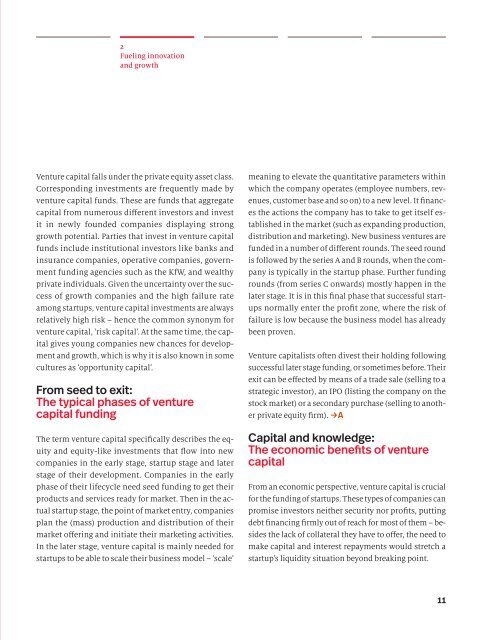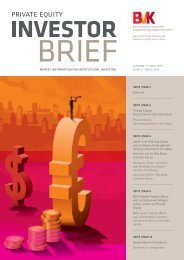Treibstoff Venture Capital (Fuel Venture Capital): Fueling innovation and economic growth
There is a lack of venture capital (VC) in Germany, especially in the growth phase of newly founded companies. As a result, the necessary capital to establish successful companies from innovative business models is lacking. In view of the international competition between technology locations, this lack weakens the innovative power of the European economy and hinders sustainable growth. The new study "Fuel Venture Capital: How we fuel innovation and growth" by Roland Berger, the Internet Economy Foundation (IE.F) and the Bundesverband Deutscher Kapitalbeteiligungsgesellschaften e.V. (Association of German Private Equity Firms). (BVK) analyses existing investment barriers to venture capital and explains how these can be overcome.
There is a lack of venture capital (VC) in Germany, especially in the growth phase of newly founded companies. As a result, the necessary capital to establish successful companies from innovative business models is lacking. In view of the international competition between technology locations, this lack weakens the innovative power of the European economy and hinders sustainable growth. The new study "Fuel Venture Capital: How we fuel innovation and growth" by Roland Berger, the Internet Economy Foundation (IE.F) and the Bundesverband Deutscher Kapitalbeteiligungsgesellschaften e.V. (Association of German Private Equity Firms). (BVK) analyses existing investment barriers to venture capital and explains how these can be overcome.
You also want an ePaper? Increase the reach of your titles
YUMPU automatically turns print PDFs into web optimized ePapers that Google loves.
2<br />
<strong>Fuel</strong>ing <strong>innovation</strong><br />
<strong>and</strong> <strong>growth</strong><br />
<strong>Venture</strong> capital falls under the private equity asset class.<br />
Corresponding investments are frequently made by<br />
venture capital funds. These are funds that aggregate<br />
capital from numerous different investors <strong>and</strong> invest<br />
it in newly founded companies displaying strong<br />
<strong>growth</strong> potential. Parties that invest in venture capital<br />
funds include institutional investors like banks <strong>and</strong><br />
insurance companies, operative companies, government<br />
funding agencies such as the KfW, <strong>and</strong> wealthy<br />
private individuals. Given the uncertainty over the success<br />
of <strong>growth</strong> companies <strong>and</strong> the high failure rate<br />
among startups, venture capital investments are always<br />
relatively high risk – hence the common synonym for<br />
venture capital, ‘risk capital’. At the same time, the capital<br />
gives young companies new chances for development<br />
<strong>and</strong> <strong>growth</strong>, which is why it is also known in some<br />
cultures as ‘opportunity capital’.<br />
From seed to exit:<br />
The typical phases of venture<br />
capital funding<br />
The term venture capital specifically describes the equity<br />
<strong>and</strong> equity-like investments that flow into new<br />
companies in the early stage, startup stage <strong>and</strong> later<br />
stage of their development. Companies in the early<br />
phase of their lifecycle need seed funding to get their<br />
products <strong>and</strong> services ready for market. Then in the actual<br />
startup stage, the point of market entry, companies<br />
plan the (mass) production <strong>and</strong> distribution of their<br />
market offering <strong>and</strong> initiate their marketing activities.<br />
In the later stage, venture capital is mainly needed for<br />
startups to be able to scale their business model – ‘scale’<br />
meaning to elevate the quantitative parameters within<br />
which the company operates (employee numbers, revenues,<br />
customer base <strong>and</strong> so on) to a new level. It finances<br />
the actions the company has to take to get itself established<br />
in the market (such as exp<strong>and</strong>ing production,<br />
distribution <strong>and</strong> marketing). New business ventures are<br />
funded in a number of different rounds. The seed round<br />
is followed by the series A <strong>and</strong> B rounds, when the company<br />
is typically in the startup phase. Further funding<br />
rounds (from series C onwards) mostly happen in the<br />
later stage. It is in this final phase that successful startups<br />
normally enter the profit zone, where the risk of<br />
failure is low because the business model has already<br />
been proven.<br />
<strong>Venture</strong> capitalists often divest their holding following<br />
successful later stage funding, or sometimes before. Their<br />
exit can be effected by means of a trade sale (selling to a<br />
strategic investor), an IPO (listing the company on the<br />
stock market) or a secondary purchase (selling to another<br />
private equity firm). →A<br />
<strong>Capital</strong> <strong>and</strong> knowledge:<br />
The <strong>economic</strong> benefits of venture<br />
capital<br />
From an <strong>economic</strong> perspective, venture capital is crucial<br />
for the funding of startups. These types of companies can<br />
promise investors neither security nor profits, putting<br />
debt financing firmly out of reach for most of them – besides<br />
the lack of collateral they have to offer, the need to<br />
make capital <strong>and</strong> interest repayments would stretch a<br />
startup’s liquidity situation beyond breaking point.<br />
11

















